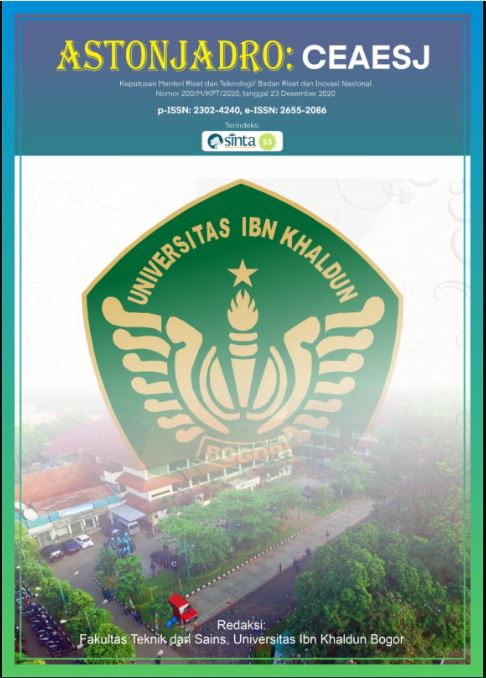EFFECT OF FREEBOARD HIGH ON WAVE REFLECTION ON ZIGZAG MODEL WCSP-DS BUILDING
DOI:
https://doi.org/10.32832/astonjadro.v11i2.6215Keywords:
WCSP-DS, wave reflection, freeboard, relative water depth, model.Abstract
The Wave Catcher Shore Protection Dual-Slope (WCSP-DS) model in this study is a model of a dual function beach building as a beach protector and a catcher of wave energy, which has two walls, namely upright and inclined walls with an angle of 45°. The WCSP-DS building also has a reservoir at its top to accommodate wave runoff (overtopping). This study aims to determine the reflection in front of the model with variations in the freeboard height of the Wave Catcher Shore Protection Dual-Slope (WCPS-DS) building in a zigzag position. The test was carried out using a 1:20 scale 3D physical model at the Coastal and Environmental Engineering Laboratory, Faculty of Engineering, Hasanuddin University, Makassar. Simulation and data acquisition were carried out in a wave basin measuring 15 meters long, 10 meters wide using a regular wave generation system and the wave height data on the wave probe was recorded automatically. The simulation was carried out with 5 variations of freeboard height on 3 variations of waves, namely wave height and period and 3 variations of water depth. The results showed that there was a significant effect of freeboard height, wave steepness and water level position on WCSP-DS vertical wall height or water depth relative to the wave reflection coefficient in front of the model. The value of the reflection coefficient (Kr) in the relationship between freeboard height and water depth (Fb/d) at a depth of 0.4 meters (d/z = 1.143) ranges from 0.42 – 0.74, at a depth of 0.35 meters (d /z = 1) ranged from 0.44 – 0.74 and at a depth of 0.3 meters (d/z = 0.857) ranged from 0.35 – 0.71.
References
A Budiono. 2014. ANALISIS PENYEDIAAN DERMAGA DI PELABUHAN UMUM ANYER BANTEN MENGHADAPI KEBUTUHAN HINGGA TAHUN 2020. ASTONJADRO: CEAESJ 3 (2), 16-28. (Indonesian).
A I D Puspita, M A Thaha, M S Pallu and F Maricar. 2020. Effect of Wave Steepness to Relative Wave Run-Up on OWEC. IOP Conf. Series: Earth and Enviromental Science 419 (2020) 012117, doi: 10.1088/1755-1315/419/1/012117
A Vidura, I W Nurjaya, M Iqbal, I Jaya. 2020. Ocean Wave Measurement and Wave Energy Calculation Using Overtopping Power Plant Scheme. IOP Conf. Series: Earth and Enviromental Science 429 (2020) 012047, doi: 10.1088/1755-1315/429/1/012047
CERC. (1984), "Shore Protection Manual”, Department of The Army Waterway Experiment Station, Corp of Engineering Research Centre Fourth Edition, US Government Printing Office. Washington.
Dean, R. G. A. Dalrymple, 1984, Water Waves Mechanics for Engineer and Scientist, Prentice Hall, Inc., New Jersey; Englewood Cliffs.
Franco,L., Csciono, C., Bellotti, G., and Andersen, T.L (2019) Laboratory Tests on the Refection Coefficient of a Perforated Caisson. The 8th International Coastal Structures Conference 2019 (pp. 253-262). http://doi.org/10.18451/978-3-939230-64-9_026
M. A. Thaha, Nizam, R. Triatmadja, A. I. Dwipuspita. (2013). Factors Affecting The Low Achievement of Utilization Efficiency of Wave Energy for Electric Power Plant with Tapered Channel Technology. Proceedings of the 7th International Conference on Asian and Pacific Coasts (APAC), 896-902
M. A. Thaha, Mukhsan P H , A. Subhan, M, A. Ildha Dwipuspita (2018). Single Slope Shore Protection as a Wave Energy Catcher. MATEC Web of Conferences 203, 01008 https://doi.org/10.1051/matecconf/201820301008
M P Hatta, A I D Puspita, M A Thaha, R Karamma, S Pongmanda, A S Mustari, and M Ibrahim (2020). Experimental Study of Wave Reflection in Breakwater Overtopping Catcher Model, IOP Conference Series: Materials Science and Engineering, doi:10.1088/1757-899X/875/1/012026
Mustapa, M. (2017). Wave energy device and breakwater integration: A review. Renewable and Sustainable Energy Reviews, 43-58
Paotonan C. 2006. Unjuk Kerja Susunan Bambu Sebagai Pemecah Gelombang Terapung. Tesis, Program Pascasarjana Universitas Gajahmada Yogyakarta. (Indonesian).
Pasquqle Contestabile, Cladio Iuppa, Enrico Di Laro, Luca Cavallaro, Thomas Lykke Andersen, Diego Vicinanza. 2017. Wave Loadings Acting on Innovative Rubble Mound Breakwater for Overtopping Wave Energy Conversion. Coastal Engineering 122 (2017) 60-74. http://dx.doi.org/10.1016/j.coastaleng.2017.02.001
Puspita, A Ildha, Muhammad Saleh Pallu, Muhammad Arsyad Thaha and Farouk Maricar (2020). The Effect of Wave Deformation on Overtopping Discharge in Wave Energy Converter (OWEC)-breakwater: Journal of Engineering and Applied Sciences Page No: 2058-2064, 2020.
Thaha, A., Maricar, F., Aboe, A. and Dwipuspita, A. (2015). The breakwater, from wave breaker to wave catcher. Procedia Engineering Elsevier, 6e 91-698
Triatmodjo, Bambang. 1996. Hidrolika II. Beta Offset. Yogyakarta. (Indonesian)
Triatmodjo, Bambang 1999. Teknik Pantai. Beta Offset. Yogyakarta. (Indonesian)
Yuwono, Nur. 1996. Perencanaan Model Hidraulik (Hydraulic Modelling). Laboratorium Hidrolik dan Hidrologi, Pusat Antar Universitas Ilmu Teknik-UGM. Yogyakarta. (Indonesian)
Z Erwanto, A Holik, AW Sanjaya. 2021. IDENTIFICATION AND PREDICTION OF COASTLINE CHANGES IN BANYUWANGI REGENCY DUE TO CLIMATE CHANGE USING GRASS QGIS. ASTONJADRO: CEAESJ 10 (2), 333-345.
Zhanhong Wan, Zhongzhi Yao, Tianyu Song and Jiawang Chen. (2018). Hydrodynamic Characteristics of the Multi-Level Overtipping Wave Power Device. Journal of Low Frequency Noise, Vibration and Active Control 0(0)1-13. DOI: 10.1177/1461348418813745.
Zhen Liu, Zhi Han, Hongda Shi,Wanchang Yang. (2017). Experimental Study on Multi-Level Overtopping Wave Energy Convertor Under Regular Wave Conditions. International journal of Naval Architecture and Ocean Engineering, volume xxx, 1-9.
Downloads
Published
How to Cite
Issue
Section
License
Paper submitted to ASTONJADRO is the sole property of the Astonjadro Journal. Unless the author withdraws the paper because he does not want to be published in this journal. The publication rights are in the journal Astonjadro.ASTONJADRO
LICENSE
This work is licensed under a Creative Commons Attribution-ShareAlike 4.0 International License.
Based on a work at http://ejournal.uika-bogor.ac.id/index.php/ASTONJADRO













